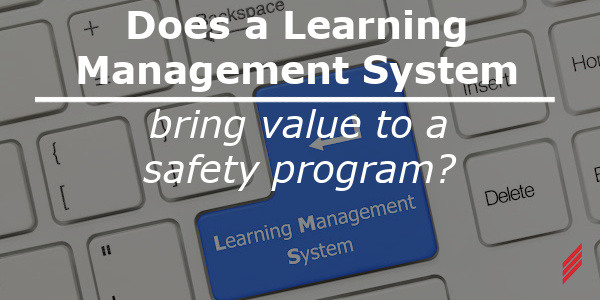Does a Learning Management System Bring Value to a Safety Program?
by Karen Hinckel on Apr 10, 2025 10:30:00 AM

Let’s face it, as Safety Professionals or Training Managers, we all know that getting compliance training scheduled, attended, and recorded can be like herding cats. Travel hiccups, unexpected employee absences, and endless paperwork can all make training seem difficult to accomplish. However, as part of an overall safety program, using a Learning Management System (LMS) can solve these problems. An LMS offers several valuable benefits that streamline training, help ensure compliance, and enhance the safety culture within the workplace.
Streamlining Compliance Training
An LMS has the capability to help streamline compliance training tracking by using various automated processes such as:
- Automated record-keeping- An LMS will document that employees have completed necessary safety training thus ensuring compliance with OSHA, NFPA®, and other regulatory agencies.
- Automatic notifications- The LMS will reduce the risk of non-compliance by sending alerts or automatic notifications to employees and/or supervisors when certifications are about to expire or when retraining is required.
- Compliance documentation- When it’s time for a regulatory audit, an LMS will simplify the audit process by easily providing required compliance documentation.
Creating a Centralized Training Resource
If employees receive different or inaccurate information or don’t get the information at all, this could create performance issues and increase the possibility of safety incidents. Utilizing an LMS will establish a centralized and accessible training resource by:
- Providing a one-stop platform- An LMS is a single place to store and access all safety-related training materials, making it easier to update and standardize content across locations.
- Providing 24/7 accessibility- Employees and supervisors can access training materials anytime, anywhere an internet connection is available, which is ideal for remote workers or those on varying shifts.
- Providing consistency in training- An LMS ensures that all employees receive standardized training, reducing knowledge gaps and enhancing overall safety understanding.
Leveraging Data & Reporting for Safety Improvement
Do you need data and reports for an upcoming audit, performance evaluation, or risk assessment? Then you can take advantage of the robust data and reporting capabilities of an LMS.
- Detailed Analytics- An LMS allows safety managers or supervisors to track training metrics such as completion rates, assessment scores, and user progress, making it easy to identify trends or areas for improvement.
- Risk Assessment and Performance Analysis- Using LMS data, managers can analyze which areas may require more focus, such as departments with low test scores, to mitigate potential hazards in the workplace.
- Customizable Reports- LMS reporting capabilities help generate tailored reports for specific needs, such as individual or departmental performance or other regulatory requirements.
Boosting Engagement & Knowledge Retention
We all know that endlessly reading slide after slide is tedious and usually does not lead to learning or knowledge retention. By using an LMS, you can foster enhanced engagement and knowledge retention through engaging activities and concepts.
- Interactive Content- Many LMSs offer multimedia and interactive features such as videos, Knowledge Checks, simulations, and scenarios, which can improve engagement and retention of safety protocols.
- Gamification Options- Integrating game-like features, such as badges or leaderboards, can make safety training more engaging and foster a competitive spirit around safety knowledge.
- Microlearning Activities- Microlearning breaks down content into smaller, focused lessons that employees can complete quickly, leading to better understanding and retention.
Adapting to Changing Safety Needs
Change is the only constant. To cope with a constantly changing environment, an LMS is fully and easily adaptable for all our ongoing and ever-changing safety needs.
- Easily Updated Content- We all know that safety standards can change frequently. With an LMS, training content can be quickly updated across the organization, ensuring everyone is informed and up to date with all the latest regulatory changes and best practices.
- Customized Training Paths- Tailored training modules can be assigned based on employee roles, skills, risk levels, or locations, ensuring that training is relevant and specific to each team member’s safety requirements.
- Scalability for Growth- As organizations grow, an LMS can quickly and easily expand to accommodate more users, making it simple to integrate new employees into the safety training program.
Who hasn’t been tasked to do more with less lately? By utilizing an LMS, you can save time and reduce expenses in a variety of ways.
- Reduced Training Costs- Digital training materials can reduce the need for in-person training sessions, travel, or printed training resources, lowering costs associated with traditional training.
- Time-Saving Automation- An LMS automates many tasks that would otherwise be manual, such as assigning training, sending reminders, and generating reports, freeing up time for other safety initiatives.
Strengthening Safety Culture & Accountability
By utilizing an LMS as a central, easily accessible, consistent point of training for accurate, up to date information, your organization’s safety culture and accountability will be greatly improved.
- Promote a Safety-First Mindset- By making safety training readily accessible and well-organized, employees are more likely to engage actively with safety content, contributing to a culture where safety is prioritized.
- Transparency and Accountability- Tracking individual progress allows managers to hold employees accountable for their safety education, fostering a stronger sense of responsibility for safety.
Enhance Your Safety Program with an LMS
AN LMS for safety education and training ultimately makes training more organized, efficient, and impactful, empowering safety professionals and training managers to better protect employees while meeting regulatory and organizational goals.
If any of these perks of using an LMS as part of your safety program sound like something that would benefit your organization, please contact Ralph Parrett at rparrett@hallam-ics.com for more information.
About the Author
Karen is an LMS Administrator with several years’ experience implementing, managing, and updating Learning Management Systems and has a bachelor’s degree in Business Administration from Northwood University. Karen learned to cross stitch and embroider as a child from her grandma and has continued to stitch throughout her life.
Read My Hallam Story
About Hallam-ICS
Hallam-ICS is an engineering and automation company that designs MEP systems for facilities and plants, engineers control and automation solutions, and ensures safety and regulatory compliance through arc flash studies, commissioning, and validation. Our offices are located in Massachusetts, Connecticut, New York, Vermont and North Carolina Texas, Florida and our projects take us world-wide.
You May Also Like
These Related Stories

Isolated Remote Site Deployments-Man Camp Part 1–Intro and General Preparation

Isolated Remote Site Deployments-Man Camp Part 2–Your Site Requirements and Reality of Life On-Site




No Comments Yet
Let us know what you think